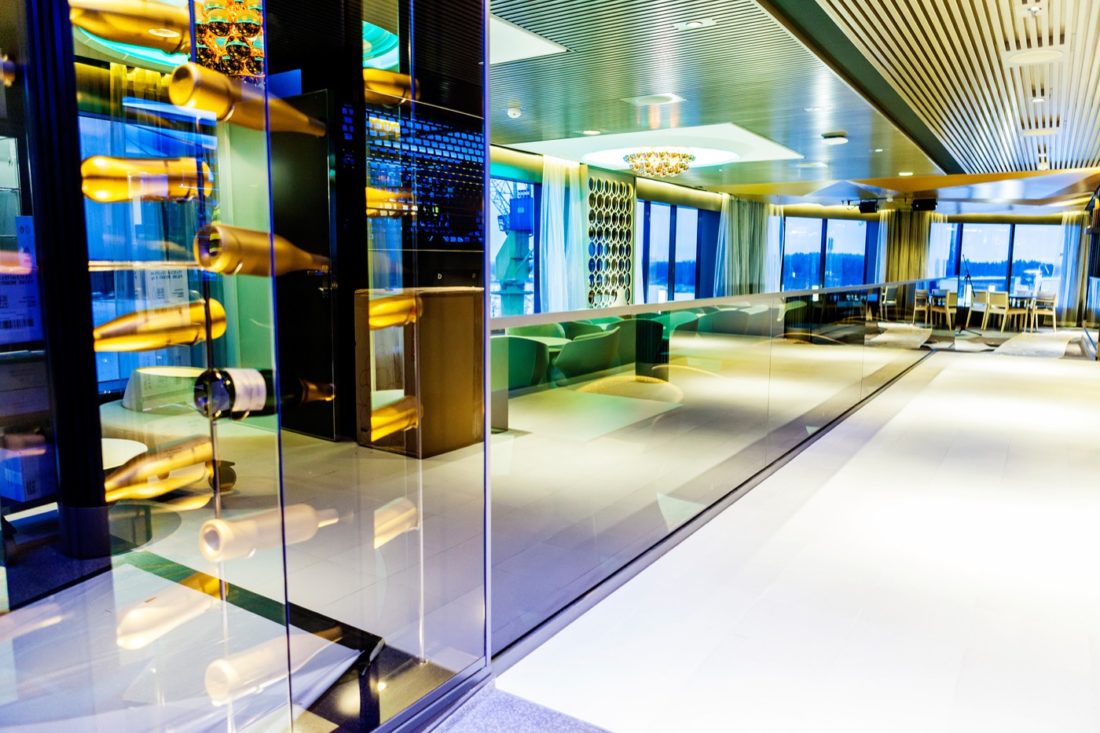Safety glass
When safety matters
How the glass is used is what mainly defines the features that are required from the glass. Nowadays a combination of laminated and toughened glass is used in walls and railings to achieve the best possible safety level, especially in public spaces.
The laminated glass that we deliver is made according to international safety standards. Thus, our safety glass is as secure as possible even if it breaks, as the laminated safety glass stays in its plastic film and no shards come off in case of breakage. Our safety glass range also includes burglarproof and bulletproof glass.
REQUEST AN OFFER ON THE SAFETY GLASS »
Toughened glass – a diverse and durable choice
Toughened glass is a long-lasting and durable glass type and its surface resistance is 4-5 times compared to unhardened glass. Toughened glass stands heavy loads, even hard kicks. It’s a characteristic for a toughened glass that it breaks into small, blunt-edged pieces when it breaks and doesn’t cause harm to the environment. Toughened glass is typically used in railings, balconies, glass doors, shower stalls, as floor glass and as facade glass.
In the toughening process, the glass is heated to 650°C and quickly cooled back to room temperature. During the process powerful compression stress and tension stress are formed on the surface of the glass which increases the toughness of the glass to endure hits, bending and temperature changes much better compared to regular glass. Before toughening, the glass is made into its final shape (drilling, holes, grinding, etc.).
Depending on the requirements of the final product, the toughened glass sheet can be kept flat or bent into the desired shape during the toughening process.

Toughened safety glass that is prone to breakage is separated during the production phase with a Heat Soak Test
Toughened glass breakage by itself is rare, but it happens sometimes. The Heat Soak Test (HST) thermal treatment is a treatment that can be combined with the post-treatment of the glass and its purpose is to find and break safety glass that is at risk of breaking during the production phase.
One of the known reasons for toughened glass breaking is that the nickel sulfide crystals that are contained in the float glass and that change their volume during the heating procedure of the toughening process don’t have time to revert back to their low-temperature crystal form. The nickel sulfide pieces continue to revert back to their original crystal form after the toughening process and may cause glass breakage later without any apparent reason. The fastest it happens is in ten minutes, but the breakage may also occur after the glass has already been installed for years.
If the safety glass breaks spontaneously where it has been installed, the reason for the breakage is generally impossible to find out. With glass that has been treated with the HST-treatment, it is much easier to rule out breakage due to the internal fault in the glass. Thus, the remaining reasons for breakage are the other, more common faults like incorrect installation, impact damage, changes in how it is used or extra load due to the surrounding structure.
Laminated glass is a durable and highly adaptable glass option
Laminated glass is made by combining two or more ordinary glasses as well as a safety glass made from PVB or EVA film using heat and pressure in a lamination furnace. The result is safety glass, that is resistant to mechanical stress and is of high optical quality. The film makes the glass difficult to break, and if breaking, the shards get stuck on the plastic film and won’t spread into the environment.
The appearance of the laminated glass can be changed with films and different inserts. The films come in different colors, both transparent and opaque options. Nearly limitless color options can be achieved by combining the films. By utilizing inserts that are put between the glasses, the end product becomes prominent and unique. Laminated safety glass can also be bent to the desired angle.
Laminated safety glass is used in, for example, entrances and doors, as railing glass, roof glass as well as burglar- and bulletproof glass.
Burglar- and bulletproof glass
The purpose of burglar-proof glass is to prevent burglars getting inside with “ordinary” measures such as breaking the glass with a crowbar or a brick. The structure of the burglar-proof glass is a threefold laminated safety glass with thick films. The structure of the glass naturally depends on the glazing target.
The purpose of bulletproof glass is to protect the people and property behind the glass. The only type of glass that fulfils this purpose is laminated safety glass. The structure of the bulletproof glass consists of several different glasses of different thicknesses and PVB films, but also polycarbonate plates are used in the combination. Bulletproof glass is categorized into five different categories depending on what kind of calibers they need to protect against. Category-specific calculations of the strength the glass structure requires are always made on a case-by-case basis.